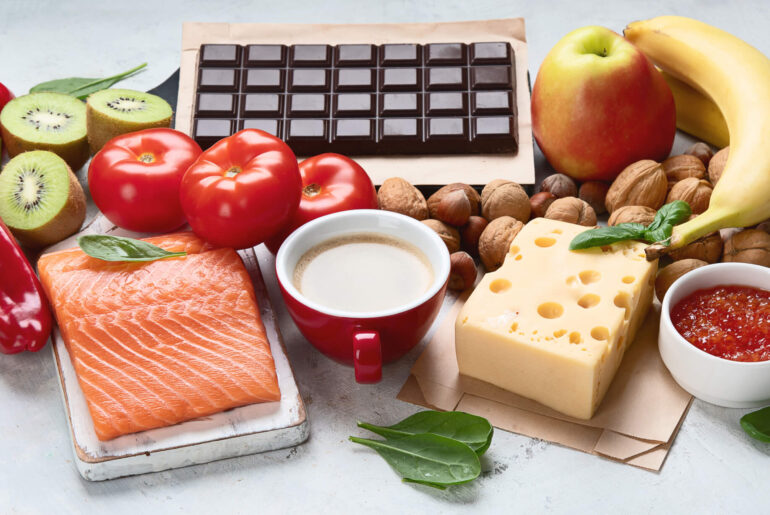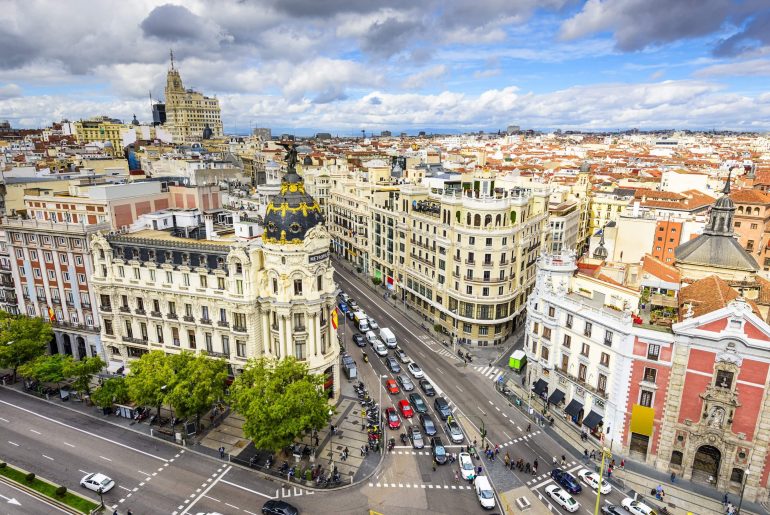Foods for a Better Mood and Reduced Anxiety: Boost Your Mental Health with Nutrition
Feeling anxious or down? The answer might not be in a pill bottle, but rather on your dinner plate. As science rapidly unearths the powerful link between nutrition and mental health, it’s clear that what we eat can significantly influence our mood and anxiety levels. This blog post uncovers the top foods that promote positive mental health and highlights how incorporating them into your daily menu can provide an exciting path to better wellbeing – both mentally and physically. Harnessing the power of food as medicine may be your most delicious strategy yet against anxiety and mood imbalances. Dive in, explore, and prepare for a joyful journey to wellness!
Certain foods can improve your mood and reduce anxiety by increasing levels of serotonin, dopamine, and other feel-good chemicals in the brain. These include fruits, vegetables, whole grains, lean meats, fish, nuts and legumes, low-fat dairy, and olive oil. Additionally, a Mediterranean-style diet rich in zinc, folate, magnesium, potassium, vitamin C, fiber, iron, B vitamins, and omega-3 fatty acids has been shown to be particularly beneficial for mental health. However, it is important to note that while food may have an impact on mood and anxiety, it should not be considered a substitute for professional medical treatment if needed.
The Role of Food in Mood and Anxiety
Our diet plays a significant role not only in our physical health but also in our mental well-being. Research has shown a strong connection between the food we consume and our mood, cognitive function, and risk for anxiety disorders. How does food impact our mood and anxiety levels? Let’s explore:
Firstly, certain nutrients found in food are fundamental in the production of neurotransmitters, chemicals that transmit messages within the brain. For instance, serotonin, a neurotransmitter that affects sleep regulation, mood, and appetite, is found in the gut. High-quality diets are correlated with feel-good hormones like serotonin and dopamine.
Imagine sitting down to a meal consisting of salmon paired with leafy greens and quinoa. The omega-3 fatty acids from the salmon contribute to brain health and mood regulation, while the dark leafy greens provide important vitamins and minerals like magnesium and folate that promote mental well-being. The combination of these nutrients can help alleviate symptoms of anxiety and improve your overall mood.
Furthermore, emerging research suggests that our gut health plays a crucial role in modulating our mood. The complex network of nerves embedded within our digestive system, often referred to as the “second brain,” communicates bidirectionally with our central nervous system. This connection is known as the gut-brain axis.
Picture this: you’re experiencing butterflies in your stomach before an important presentation or feeling nauseous when dealing with stress. These sensations illustrate the link between your emotions and your gut.
Now here’s where it gets interesting; the bacteria residing in our gut (known as the gut microbiota) produce neurotransmitters like serotonin. Thus, maintaining a healthy gut through proper nutrition can have a direct impact on our mood and anxiety levels.
So how can we harness the power of nutrition to support better mental health? By focusing on key nutrients that have been shown to be essential for mental well-being.
Nutrients Essential for Mental Health
Foods that contain mood-boosting nutrients include fruits and vegetables, whole grains, lean meats, fish, nuts and legumes, low-fat dairy, and olive oil. These foods are rich in zinc, folate, magnesium, potassium, vitamin C, fiber, iron, B vitamins, and omega-3 fatty acids. Incorporating a variety of these nutrient-rich foods into our daily diet can play a vital role in supporting our mental health.
Now you might wonder if there’s a specific “miracle food” that can instantly boost your mood or alleviate anxiety. The truth is that no single food or type of food can cure depression or eliminate anxiety disorders. However, making changes to your overall diet can certainly help alleviate occasional blue moods or reduce feelings of anxiety.
So, instead of seeking a magical solution to one particular food item, think of focusing on the bigger picture – adopting a balanced and diverse diet that prioritizes these mood-enhancing nutrients. It’s about creating an overall pattern of eating that supports good mental health.
With this understanding of the role food plays in our mood and anxiety levels and the essential nutrients we should focus on, let’s dive deeper into the fascinating gut-brain connection and how it impacts our emotional well-being.
- Eating a balanced and diverse diet that incorporates mood-boosting nutrients like zinc, folate, magnesium, potassium, vitamin C, fiber, iron, B vitamins, and omega-3 fatty acids can play a crucial role in supporting our mental health. While no single food or type of food can cure depression or eliminate anxiety disorders, making changes to your overall diet can certainly help alleviate occasional blue moods or reduce feelings of anxiety. Therefore, instead of seeking a magical solution to one particular food item, it’s essential to focus on creating an overall pattern of eating that supports good mental health.
Gut-Brain Connection and Mood
Our gut and brain are intricately connected through the enteric nervous system, often termed the “second brain.” This connection plays a vital role in regulating our mood and emotions. The trillions of bacteria residing in our gut, known as the gut microbiota, have a significant impact on our mental health. These gut microbes produce neurotransmitters like serotonin and dopamine, known as “feel-good” chemicals that regulate mood and overall well-being.
Studies have found that disturbances in the gut microbiota composition can lead to changes in brain chemistry and contribute to mood disorders such as anxiety and depression. Factors like stress, poor diet quality, lack of sleep, and certain medications can disrupt the balance of our gut microbiota, affecting our mental health.
To support a healthy gut-brain connection and promote positive moods, it’s crucial to nourish our bodies with foods that optimize our gut microbiota.
Mood-Boosting Foods and Their Benefits
When it comes to enhancing your mood and reducing anxiety, incorporating specific foods into your diet can make a remarkable difference. These foods are packed with mood-boosting nutrients, vitamins, and minerals that support optimal brain function and emotional well-being. Let’s explore some key mood-boosting foods and their benefits:
1. Fruits and Vegetables: Fresh fruits and vegetables provide an abundance of essential vitamins and minerals that play a role in neurotransmitter production. They are rich in antioxidants that help reduce inflammation in the brain, promoting better mental health.
2. Whole Grains: Whole grains like quinoa, brown rice, oats, and whole wheat bread contain fiber, B vitamins, magnesium, and other mood-enhancing nutrients. They have a slow-release effect on blood sugar levels, preventing energy crashes that can affect mood negatively.
3. Lean Meats: Lean meats like chicken breast or turkey contain tryptophan, an amino acid that supports serotonin production. Serotonin is a neurotransmitter that regulates your mood and provides a sense of calm and well-being.
4. Fish: Fatty fish like salmon, mackerel, and sardines are excellent sources of omega-3 fatty acids. These healthy fats are essential for brain health, reducing inflammation, and promoting optimal cognitive function.
5. Nuts and Seeds: Almonds, walnuts, flaxseeds, and chia seeds are packed with nutrients like vitamin E, magnesium, and omega-3 fatty acids. These nutrients have been linked to improved mood and reduced symptoms of anxiety and depression.
6. Legumes: Beans, lentils, and chickpeas are rich in protein, fiber, and vitamins that contribute to stable blood sugar levels, providing steady energy throughout the day. They also help increase serotonin production, giving your mood a boost.
7. Low-Fat Dairy: Foods like yogurt or milk contain tryptophan and calcium—essential components for serotonin synthesis. They can have a positive impact on mood regulation.
Incorporating these mood-boosting foods into your daily diet can provide you with the nutrients necessary for optimal brain health and emotional well-being. Remember that no single food is a cure-all for mental health issues; it’s important to talk to a healthcare professional if you experience persistent feelings of anxiety or depression.
Having understood the importance of the gut-brain connection and explored some mood-boosting foods, let’s now delve into the specific impact of whole grains and proteins on our mood.
Impact of Whole Grains and Proteins
Whole grains and proteins play a pivotal role in our mental well-being, offering numerous benefits that can positively impact our mood and reduce anxiety levels. Let’s explore how these important nutritional components contribute to better mental health.
Whole grains provide a steady release of energy throughout the day, preventing the blood sugar spikes and crashes associated with refined carbohydrates. This stable energy supply supports brain function and helps regulate mood. Studies have shown that individuals who consume more whole grains have a lower risk of developing depression and anxiety disorders. The rich fiber content in whole grains also promotes gut health, which is increasingly recognized as a crucial factor in mental well-being.
For instance, starting your day with a bowl of oatmeal – a nutritious whole grain – coupled with some nuts or nut butter for added protein can provide long-lasting energy and improve cognitive function. It also helps stabilize blood sugar levels, reducing irritability and promoting a calm state of mind.
Think of whole grains as the solid foundation on which our mental health is built – they provide sustenance, stability, and fuel for optimal brain function.
On the other hand, proteins are essential for the production of neurotransmitters like serotonin and dopamine, which play vital roles in regulating mood. Including sufficient protein in your diet can help maintain balanced brain chemistry and support emotional well-being. Foods rich in protein, such as lean meats, poultry, fish, legumes, and dairy products, are not only excellent sources of this macronutrient, but often contain other nutrients that are beneficial for mental health.
Now you might wonder whether plant-based proteins are equally effective for boosting your mood compared to animal-based sources. While it is true that plant-based proteins lack certain essential amino acids found in animal proteins, they can still contribute to improved mental health when combined with other plant-based protein sources. For example, consuming a variety of legumes, soy products, nuts, and seeds can provide all the essential amino acids needed for optimal brain health.
Personal experience: As someone who follows a plant-based diet, I have found that incorporating a diverse range of plant-based protein sources has positively impacted my mood and reduced anxiety levels. Lentils, chickpeas, tofu, and quinoa have become staples in my meals, helping me maintain a balanced and calm state of mind.
Understanding the impact of whole grains and proteins on our mental well-being sets a solid foundation for making informed decisions about the foods to include in our diet. However, it is equally important to be aware of the foods that we should avoid to support better mental health.
Foods to Avoid for Better Mental Health
When it comes to enhancing our mental health through nutrition, certain foods should be consumed in moderation or avoided altogether. These foods have been shown to have detrimental effects on mood regulation and can exacerbate anxiety symptoms. Let’s explore some key culprits that can contribute to compromised mental well-being.
High consumption of highly processed foods has been linked to an increased risk of depression and anxiety. These convenient and often tempting options like packaged snacks, sugary drinks, fast food, and processed meats, are typically loaded with unhealthy fats, refined sugars, preservatives, and artificial ingredients that offer minimal nutritional value. They may also lead to inflammation in the body, which has been implicated in mental health issues.
Instead of reaching for a bag of chips or a candy bar as a pick-me-up during moments of stress or low mood, consider opting for healthier alternatives like air-popped popcorn or a piece of dark chocolate. These choices not only satisfy cravings but also provide antioxidants and other beneficial compounds that support our mental well-being.
While highly processed foods are a key concern, there are specific food categories that have been found to negatively impact mental health. Let’s explore them further.
- According to the American Psychiatric Association, nearly 20% of adults in the United States experience an anxiety disorder each year, highlighting the importance of dietary and lifestyle interventions.
- A 2017 study found that individuals adhering to a Mediterranean diet, rich in fruits, vegetables, lean proteins, and healthy fats like olive oil, had a 33% lower risk of developing depression compared to those who did not follow this diet.
- Another study published in the “American Journal of Psychiatry” in 2010 revealed that women with diets richer in vegetables, fruit, meat, fish, and whole grains were less likely to suffer from anxiety disorders.
Personalized Diet Strategies for Anxiety Reduction
When it comes to managing anxiety through diet, there are no one-size-fits-all solutions. Each individual may respond differently to various foods and dietary approaches. To develop a personalized diet strategy for anxiety reduction, it’s important to consider several factors such as your specific nutritional needs, any existing medical conditions, and your body’s unique response to different foods.
One of the key considerations in creating a personalized diet strategy is maintaining stable blood sugar levels. Consuming complex carbohydrates can help achieve this by providing a steady release of energy throughout the day. Instead of relying on processed foods, opt for whole grains, vegetables, and fruits that offer a healthier source of carbohydrates. Incorporating these nutrient-rich options into your meals can promote a more even blood sugar level and contribute to a calmer feeling.
Furthermore, including foods rich in magnesium can be beneficial for anxiety reduction. Leafy greens, legumes, nuts, seeds, and whole grains are excellent sources of magnesium. This mineral plays a vital role in regulating certain neurotransmitters involved in mood regulation and has been associated with lowered anxiety levels.
In addition to magnesium, zinc-rich foods can also have a positive impact on reducing anxiety symptoms. Oysters, cashews, liver, beef, and egg yolks are all good sources of zinc. It has been suggested that zinc plays a role in modulating the brain’s stress response system and may help alleviate feelings of anxiety.
For instance, imagine John who suffers from chronic anxiety. After consulting with a nutritionist, he discovered that his diet lacking in magnesium-rich foods like leafy greens or whole grains might be contributing to his persistent symptoms. By incorporating more spinach salads or quinoa bowls into his meals each day, John notices a gradual improvement in his overall mood and reduced instances of heightened anxiety.
Omega-3 fatty acids found in fatty fish such as wild Alaskan salmon have also been shown to have anxiety-reducing effects. These healthy fats can help decrease inflammation in the body and support optimal brain function. Including fatty fish in your diet a few times a week or considering omega-3 supplements can be an effective way to introduce these beneficial compounds into your system.
Probiotic-rich foods like pickles, sauerkraut, and kefir have also been linked to lower social anxiety. The gut-brain connection is gaining attention within nutritional psychiatry, as studies suggest that the health of our gut microbiome plays a role in mental well-being. By nurturing the gut with beneficial bacteria through probiotic foods or supplements, individuals may experience reduced anxiety symptoms.
While incorporating specific nutrients into your diet can provide potential benefits for anxiety reduction, it’s important to remember that nutrition alone cannot independently treat or cure anxiety disorders. A holistic approach that includes therapy, medication (if necessary), regular physical activity, and adequate self-care is crucial for managing anxiety effectively.
Is it possible to get enough of these mood-boosting nutrients through diet alone, or do supplements need to be taken?
It is possible to get enough mood-boosting nutrients through diet alone, without the need for supplements. A balanced and varied diet that includes foods rich in essential nutrients like omega-3 fatty acids, B vitamins, magnesium, and zinc can effectively support mental health. For instance, salmon, walnuts, spinach, and dark chocolate are excellent food sources of these mood-enhancing nutrients. According to a study published in the American Journal of Psychiatry, a Mediterranean-style diet rich in fruits, vegetables, whole grains, and lean proteins significantly reduces the risk of depression by 33%. So, prioritizing nutrient-dense foods can be an effective way to boost mental health naturally.
How long does it take for dietary changes to result in improved mood and reduced anxiety?
Dietary changes can start to have a positive impact on your mood and reduce anxiety within a few weeks. Research suggests that certain nutrients, like omega-3 fatty acids and magnesium, have significant effects on mental health. For instance, a study published in the Journal of Clinical Psychiatry found that omega-3 supplementation led to a significant reduction in anxiety symptoms after just three weeks. Another study published in the Australian & New Zealand Journal of Psychiatry showed that magnesium supplementation improved depressive symptoms within two weeks. While individual responses may vary, these findings highlight the potential for dietary changes to yield relatively quick improvements in mood and anxiety levels.
Are there any other lifestyle changes that can be made alongside dietary changes to further improve mental wellbeing?
Absolutely! In addition to dietary changes, incorporating regular physical activity has been shown to have a positive impact on mental wellbeing. Research suggests that exercise can reduce symptoms of anxiety and depression by releasing endorphins, improving sleep quality, and boosting self-esteem. According to a study published in The Lancet Psychiatry, individuals who exercised had 43% fewer days of poor mental health compared to those who didn’t engage in physical activity. So, combining healthy eating with exercise is a powerful duo for enhancing mental health.
Are there any foods that can actually make anxiety or depression worse?
While diet plays a crucial role in mental health, certain foods can indeed exacerbate anxiety and depression. Research suggests that excessive consumption of processed foods high in sugar and trans fats may increase the risk of developing these conditions. A study published in the American Journal of Clinical Nutrition found that individuals who regularly consume fast food are more likely to experience depression compared to those who opt for a healthier diet. Additionally, caffeine and alcohol can also contribute to heightened anxiety symptoms. To promote better mental health, it is important to focus on a nutritious diet consisting of whole foods and avoid or limit the consumption of these detrimental food items.
Which specific nutrients in food have been shown to improve your mood and reduce anxiety?
Various nutrients have been shown to improve your mood and reduce anxiety. Omega-3 fatty acids found in fish, walnuts, and chia seeds have been linked to a lower risk of depression and improved mental well-being. Vitamin D, obtained from exposure to sunlight or fortified foods, has also been associated with better mood regulation. Additionally, magnesium and zinc, found in leafy greens, nuts, and whole grains, play important roles in the production of neurotransmitters that affect mood. Furthermore, studies have shown that probiotics found in fermented foods like yogurt can positively impact mental health by modulating the gut-brain axis. Finally, antioxidants like vitamin C and E found in fruits and vegetables help reduce oxidative stress and inflammation, contributing to improved mental health.











